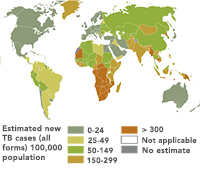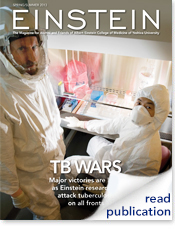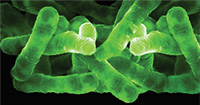

FULL STORY
TB Wars: Major Victories Are Likely

In 2011, TB sickened some 8.7 million people and took some 1.4 million lives, according to the World Health OrganizationOne-third of all people on Earth are infected with Mycobacterium tuberculosis, the tuberculosis (TB) bacterium. The vast majority of those people are only latently infected and suffer no ill effects, but that’s hardly cause for comfort. About one in 20 latent infections eventually progresses to active disease, with symptoms that include coughing, fever, fatigue and weight loss. If untreated, active TB kills about half its victims. Death can usually be prevented if active TB is caught early and properly treated—big “ifs” in the developing world, where most cases occur.

This article was originally published in the spring/summer 2013 issue of Einstein magazineThe numbers tell the story of TB’s terrible toll: In 2011, TB sickened some 8.7 million people and took some 1.4 million lives, according to the World Health Organization. Africa, Russia, China and Southeast Asia have been especially hard hit.
At the risk of anthropomorphizing a microbe, M. tuberculosis is highly intelligent. It has figured out how to fend off all threats to its existence, from nature’s immune cells to humankind’s vaccines and medications. And the AIDS epidemic of the last 30 years has magnified TB’s impact. In people co-infected with HIV and TB, immune systems weakened by HIV can no longer suppress TB. Co-infection has not only made TB more deadly but has greatly increased the number of active TB cases. Studies show that the risk of developing active TB is between 20 and 37 times greater among HIV-positive people; in some sub-Saharan countries, up to 80 percent of TB patients are infected with HIV.

Mycobacterium tuberculosis is the bacterium that causes TBAlthough scientists have come up with a variety of powerful mycobacterial-fighting antibiotics, the wily TB bacterium inevitably finds a way to evolve and resist the chemical onslaught. Some 650,000 people worldwide now have multidrug-resistant TB.
An even greater impediment to ridding the world of TB is the absence of an effective vaccine. Remarkably, after more than a century of research, there is still just one vaccine against TB: the Bacille Calmette-Guérin (BCG) vaccine, prepared from a strain of the bovine tuberculosis bacillus, Mycobacterium bovis. The live attenuated (weakened) BCG vaccine has been used in humans since 1921 and has proven notoriously inconsistent in protecting against TB.
At Einstein, home to one of the country’s most comprehensive TB research programs, developing better TB vaccines is a top priority. Two teams of Einstein scientists are working on novel TB vaccines that may one day replace the BCG vaccine. Einstein researchers are also deciphering M. tuberculosis’ secrets gene by gene, seeking vulnerabilities in the TB genome that could be targeted by new drugs. And for countries with raging TB epidemics, Einstein scientists are devising better strategies for caring for patients, and developing tests that rapidly detect active TB infections and indicate which antibiotics will work best for each patient.
In this battle between man and microbe, M. tuberculosis still has the upper hand—but maybe not forever. Thanks to the efforts of Einstein researchers, TB may one day join smallpox on the short list of extinct microbial killers.

Dr. Jacqueline M. Achkar
The Holy Grail in TB Diagnosis:
Quick, Simple and Inexpensive

Dr. Max R. O'Donnell
A New Gold Standard for
Diagnosing TB?

Dr. James C.M. Brust
Go South, Young Man

Dr. John S. Blanchard
Attacking Drug-Resistant TB with a One-Two Punch

Dr. John Chan
B Cells, the Forgotten Weapon

Dr. William R. Jacobs
The Persister

Dr. Steven A. Porcelli
The Accidental Tuberculologist
Posted on: Tuesday, October 15, 2013

Tablet Blog